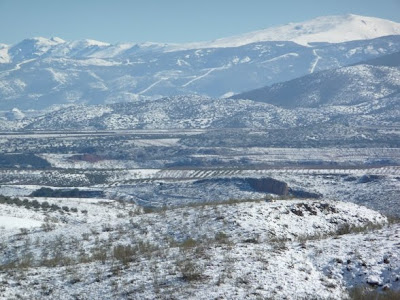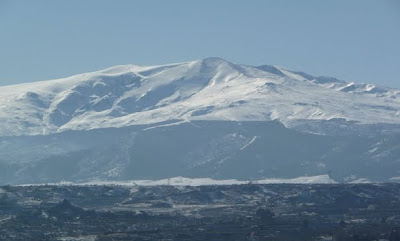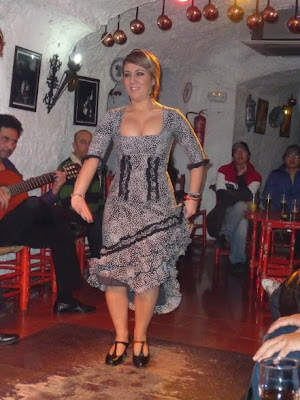The Alhambra is actually three or four sites, the Palacios Nazaries, the Generalife gardens, Charles V's palace, and the old fortress, the Alcazaba. The Palicios Nazaries is the main thing, the last palace of the retreating Moors, built in the 13th and 14th centuries, handed over to Ferdinand and Isabella in 1492. (Ferdie and Izzie were
really multi-tasking that year). We spent the better part of the day seeing all this, reputedly the top site in all Spain.
They say what you get from something depends a lot on what you bring to it. I confess I do not bring a great deal of knowledge about Muslim art or religion to these sites. Rarely do they do anything but geometrical forms and calligraphy of lines from the Koran. Particularly in religious settings, there can be no copies (graven images) of nature, people, etc. Not even half way through the Nazaries, I felt myself actually yearning for a St. Sebastian, an Annunciation, a Chinese landscape, even a Picasso. How long can you stare, with interest, at a kaleidoscope?
Maybe it was the season, the lack of novelty, or something else, but I was less impressed with the Alhambra than with the Alcozaba in Seville or, especially, the Mezquita in Cordoba (apples and oranges, yes, I know). The audio-guide, with its deadening, I mean, soothing, music and voices, saturated with Washington Irving (ick!) style romance/fantasy of the Alhambra did not help. When Irving found the Alhambra in the 1820s or 1830s, it was a fair ruin. The job of rebuilding it, deliberately, as a national monument/tourist destination must be as interesting a story as anything Boabdil or Ferdinand or Isabella did here. But that story's not much told. And for the rest, you are asked to use your imagination as to what things looked like, who was there, what was going on, etc. Personally, I have very weak imaginative powers when it comes to sultans and sultanas, ambassadors and emissaries, et al., although I do a little better with harems.
 |
Great hall; Court of the Myrtles (?) |
 |
Courtyard |
 |
Column |
 |
A water feature outside the Comares, the throne room, historically important because a) that's presumably where the Moorish king Boabdil surrendered, and b) presumably where Columbus made his pitch to the Royals (wasn't he already abroad, so to speak?) |
 |
Looking the other way |
 |
Entry to the court of the two sisters, or was it two cousins? |
 |
More water features; since it rained most of the day, and was chilly, we were less impressed by all the water features than we might have been in, say, August; besides, I was kaleidoscoped-out by this point; brain-dead |
 |
Really into columns |
 |
This is the fountain of the twelve lions, or somesuch, which in some sense told time, or season, or month...whatever; the lions are away being reconditioned, or possibly hibernating |
 |
Artsy-fartsy attempt to amuse myself |

























































